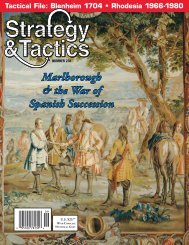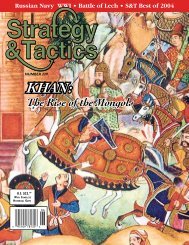COUNTERSTROKE AT SOLTSY - Strategy & Tactics Press
COUNTERSTROKE AT SOLTSY - Strategy & Tactics Press
COUNTERSTROKE AT SOLTSY - Strategy & Tactics Press
You also want an ePaper? Increase the reach of your titles
YUMPU automatically turns print PDFs into web optimized ePapers that Google loves.
The Early Years<br />
In 1584, Miyamoto Musashi was born into a minor<br />
branch of the samurai nobility. He was orphaned<br />
at an early age and brought up by his uncle, a priest<br />
and samurai. Little is known of his early years, but<br />
Musashi himself has written he fought his first duel<br />
when he was only 13 years old. Since he was the son<br />
of a low ranked samurai, it is probable his uncle had<br />
schooled him in kendo (or kenjutsu), sword-fighting<br />
technique.<br />
The duel is mentioned in the Introduction to<br />
Musashi’s book on strategy and life, The Book of the<br />
Five Rings, his great legacy to Japan. In it he sets out<br />
the story of his life and the philosophy of his warrior<br />
code: the way of the sword. The book was written<br />
by Musashi late in life, as a series of letters to one<br />
of his students, but was not compiled until long after<br />
his death when his students collated the stories of his<br />
duels and preserved his philosophy.<br />
Musashi was an exceptional warrior who combined<br />
the great natural abilities of a prodigy with thorough<br />
training. His skill, courage and focused ruthlessness<br />
made him a formidable warrior with his chosen weapon,<br />
the sword. At 16 he fought and won another single-handed,<br />
mortal-combat duel against a samurai. As<br />
the samurai class lived and trained constantly for just<br />
such professional duels, those two victories at such a<br />
young age marked Musashi as having the potential to<br />
be as a legendary swordsman. And such legends were<br />
common in Japan. For example, there was Tsukahara<br />
Bokuden who, a century before, had traveled the land<br />
as a wandering ronin. The ronin were unattached samurai<br />
without mentors or allegiances to specific lords.<br />
They sometimes sought employment as teachers of<br />
martial skills or mercenaries.<br />
Soon after his second duel, Musashi began his own<br />
pilgrimage as a ronin in search of enlightenment. For<br />
the next three years his life was solely focused on developing<br />
his martial skills and seeking enlightenment<br />
through the way of the sword. His dedication was such<br />
that he did not wash, was unkempt and wandered Japan<br />
in poverty until he joined in the fight for the Shogunate<br />
as a samurai in the pay of Hideyori, the son of<br />
Toyotomi Hideyoshi.<br />
Japan in the Age of the Warlords<br />
For many centuries Japan had been a land of constant<br />
warfare among local warlords. Changing alliances,<br />
assassination and a web of intrigue prevented<br />
any single family or alliance of families from gaining<br />
dominance. Each warlord feared if a rival, or even an<br />
ally, became too powerful, his own power and position<br />
would be lost. Between 1573 and 1582, the Shogun<br />
Oda Nobunaga almost succeeded in uniting the<br />
country before he too was assassinated. His successor,<br />
Toyotomi Hideyoshi, continued consolidating the<br />
gains made and in the end succeeded. With Hideyo-<br />
Spear fighting in the mountains from the Wars of the<br />
Nambokucho period.<br />
shi’s death in 1598, new wars of succession broke out,<br />
ending with the defeat and death of Hideyoshi’s son<br />
Hideyori at the decisive battle of Seki ga Hara in 1603.<br />
Tokugawa Ieyasu became shogun. He ushered in the<br />
era of his Tokugawa clan, which maintained control<br />
of the country well into the 19th century. Musashi, age<br />
19, fought at Sekigahara on Hideyori’s side, and barely<br />
escaped with his life from the merciless slaughter<br />
that took place afterward.<br />
The Tokugawas influenced every part of Japanese<br />
society. They established rules of behaviour that affected<br />
education, law and government, creating a rigid<br />
structure of four classes: samurai (including the ruling<br />
elite), farmers, artisans and merchants. Under the<br />
Tokugawa dynasty’s laws, only a samurai could wear<br />
the long sword.<br />
strategy & tactics 53







